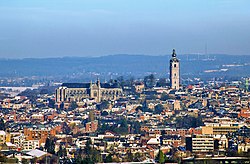Mons, Belgium
|
Mons Bergen (Dutch) |
|||
|---|---|---|---|
| Municipality | |||
 |
|||
|
|||
| Location in Belgium | |||
| Coordinates: 50°27′N 03°57′E / 50.450°N 3.950°ECoordinates: 50°27′N 03°57′E / 50.450°N 3.950°E | |||
| Country | Belgium | ||
| Community | French Community | ||
| Region | Wallonia | ||
| Province | Hainaut | ||
| Arrondissement | Mons | ||
| Government | |||
| • Mayor | Elio Di Rupo (PS) | ||
| • Governing party/ies | PS, MR | ||
| Area | |||
| • Total | 146.56 km2 (56.59 sq mi) | ||
| Population (1 January 2016) | |||
| • Total | 94,964 | ||
| • Density | 650/km2 (1,700/sq mi) | ||
| Postal codes | 7000-7034 | ||
| Area codes | 065 | ||
| Website | www.mons.be | ||
Mons (French pronunciation: [mɔ̃s]; Dutch: Bergen "mountains"; Picard: Mont) is a Belgian city and municipality, and the capital of the province of Hainaut. The Mons municipality includes the former communes of Cuesmes, Flénu, Ghlin, Hyon, Nimy, Obourg, Jemappes, Ciply, Harmignies, Harveng, Havré, Maisières, Mesvin, Nouvelles, Saint-Denis, Saint-Symphorien, Spiennes and Villers-Saint-Ghislain. Together with the Czech city of Plzeň, Mons was the European Capital of Culture in 2015.
The first signs of activity in the region of Mons are found at Spiennes, where some of the best flint tools in Europe were found dating from the Neolithic period. When Julius Caesar arrived in the region in the 1st century BC, the region was settled by the Nervii, a Belgian tribe. A castrum was built in Roman (Belgica) times, giving the settlement its Latin name Castrilocus; the name was later changed into Montes for the mountain on which the castrum was built. In the 7th century, Saint Ghislain and two of his disciples built an oratory or chapel dedicated to Saints Peter and Paul near the Mons hill, at a place called Ursidongus, now known as Saint-Ghislain. Soon after, Saint Waltrude (in French Sainte Waudru), daughter of one of Clotaire II’s intendants, came to the oratory and was proclaimed a saint upon her death in 688. She was canonized in 1039.
...
Wikipedia




